I have an affinity for subways, trains and railroads… not at the “foamer” level, but I have enough knowledge to recognize model numbers on most NYC, Long Island Rail Road and Metro-North (formerly NY Central) cars, or “equipment” as the insiders say. I know where the old els were, and where closed sections of various subway and RR lines are. I know enough that “Rail Road” is two capitalized words with the LIRR and only the LIRR.
In Part 1 I explored the west end of the Long Island Rail Road in Hunters Point and Blissville, Queens. I’m going to return to the LIRR as it goes through Maspeth and Glendale, but in Part 2, for the lack of anywhere else to put it, I’ll mention some of the Brooklyn grade crossings which all appear at the west end of the Bushwick Long Island Rail Road branch.
GOOGLE MAP: ACTIVE NYC GRADE CROSSINGS
The LIRR Bushwick Branch, probably the least-known active railroad in New York City, runs from Bushwick Place and Montrose Avenue in Bushwick, Brooklyn to its junction with the Long Island Rail Road Montauk Branch near Flushing Avenue and Rust Street in Maspeth, Queens. It’s surprisingly well-maintained in most spots, while garbage-strewn in others. Passenger service on this branch ended in 1924, but several freights and garbage hauls are found on this still-active branch during the day. It is leased by the New York and Atlantic RR, which also leases the LIRR Bay Ridge Branch, which also ended passenger service in the fateful year of 1924.
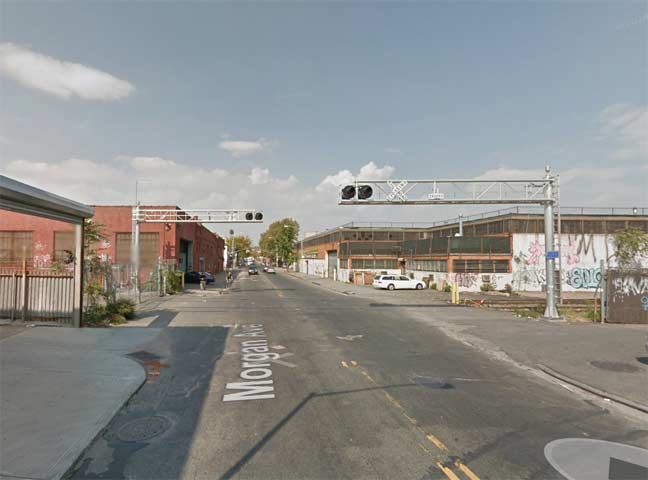
Here is a Google Street View shot of Morgan Avenue, the westernmost grade crossing on the Bushwick.
During the past decade, the Bushwick has actually gotten new grade crossing signal lights and crossbuck warning signs, replacing small crossbuck signs that were in different states of maintenance; the LIRR eliminated the gates in 1990 because of so little service on this line. These improvements were made after a LIRR loco got loose in March 2004 after, as a Forgotten NY commenter says, “the train crew deliberately disconnected the locomotive and left it unattended. It rolled away due to the failure of safety devices in the air brake system, after the crew neglected to set the manual hand brake & wheel chocks as they were required to do.” The loco got onto the Bushwick branch and traveled unsupervised down the tracks, plowing into several vehicles and injuring motorists. The LIRR initiated changes in the rules regarding braking and installed tall signals with flashing lights. In addition, when a freight is due to cross, a flagman is positioned in the road to stop traffic.
Morgan Avenue is the easternmost continuous north-south road connecting Bushwick with eastern Greenpoint. In the 19th Century, the Morgan family surveyed this part of town in anticipation of the construction of the street grid.

The next crossing heading east on the branch is at Varick Avenue. At this point the Bushwick has just crossed the southern end of the English Kills, a tributary of Newtown Creek. In the colonial era, two streams emanating from the Newtown were named Dutch and English Kills; Dutch Kills ran north into Dutch-held territory, while English Kills south into British land. In 1664 the British appropriated all of New Netherland from the Dutch.
Note the lack of blinking signals at this crossing.
Just west of Varick Avenue, the so-called Evergreen Branch of the LIRR diverged from the Bushwick and ran southeast, joining the Bay Ridge Branch at the border of Evergreens Cemetery, hence the name. Most traces of the Evergreen have now been eliminated, but when I first began working on FNY in 1998, the occasional trackway or even crossbuck sign could be seen along its old route, which was mostly a right-of-way just south of Wyckoff Avenue.
Varick Avenue in Brooklyn, which mysteriously changes its name to Varick Street for one block in Greenpoint between Nassau Avenue and Bridgewater Street, is, like Manahattan’s Varick Street, named for George Washington’s personal secretary, Richard Varick, who later became an early mayor of NYC. He was also an aide-de-camp of General Benedict Arnold before the latter’s betrayal.
These are the only two grade crossings remaining in Brooklyn on public streets! There are others in trainyards, of course.
Just barely into Queens past the Brooklyn boro line, the Bushwick crosses both Woodward Avenue and Metropolitan Avenue at grade.
The Woodward crossing, above, is a single track. It was given a high grade cross sign, but no lights. In this part of town you’ll find furniture wholesalers and nondescript warehouses.

Metropolitan and Woodward Avenues, looking west toward #1 World Trade Center. Metropolitan Avenue is major east-west truck route extending from the East River in Williamsburg, Brooklyn out to Jamaica Avenue. Around 1815 it was built as a tolled plank road called the Williamsburg and Jamaica Turnpike, but by mid-century the tolls were removed and the name changed to Metropolitan Avenue. Unlike many major routes, it’s still a modest 4-lane street (two allowing for parking) and has been widened in only a couple of stretches along its 10-mile length.
The Bushwick Branch crosses Metropolitan Avenue just east of its Woodward Avenue crossing. The tracks here pass some freightyards, a Western Beef supermarket and a warehouse whose open door revealed what I perceived to be Hindu idols (correct me if I’m wrong) and colorful clothing. This busy road rates flashing lights on the grade cross.
East of Metropolitan, the Bushwick Branch crosses 54th, 55th and 56th Streets just to the north of Flushing Avenue.
At 54th Street, we see an industrial, blue collar scene as the railroad abuts Maspeth Welding, with its marvelous metal sign in the Futura Medium font. Futura, before the advent of Helvetica in 1957, was the go-to sanserif font for headlines, along with Trade Gothic, News Gothic, Erbar and other lesser makes.
55th Street features more residences than does 54th Street, including this building with an interior porch nestled right next to the right of way. Since the Bushwick branch dates to the 1880s, the house was knowingly built right next to the tracks. I haven’t hung around long enough to tell, but I imagine there are only a few runs a week here, so the noise and inconvenience is minimized. Hopefully.

The LIRR tracks cross 56th Street literally a couple of feet away from its junction with Flushing Avenue, but it still counts as a grade crossing. It’s unmarked by signals or crossbuck signs.
There are two RR crossings on Flushing Avenue, each one handled differently. It’s important to note that some decades ago, Flushing Avenue was depressed below both the Bushwick Branch and the LIRR Montauk tracks, which are quite close to each other at this point, with both merging nearby at what is called Bushwick Junction. Here, Flushing Avenue becomes a de facto expressway between 54th and 59th Streets.
The Bushwick branch crosses Flushing Avenue at grade, and there are signals at Flushing Avenue’s surface service roads. The Bushwick actually enters a building just before it merges with the Montauk tracks. Here, pedestrians can cross the tracks as normal, since the Bushwick gets so little traffic.
At the Montauk grade crossing, though, there are no service roads at all and pedestrians, what few there are, have to descend some steps and proceed along a catwalk above the Flushing Avenue open cut to get under the tracks.
Berlin/West Maspeth/Laurel Hill
Moving back up the Montauk tracks to a mostly industrial neighborhood between Laurel Hill Boulevard at Calvary Cemetery on the west, 58th Street on the east, Maspeth Creek on the south and Mount Zion Cemetery on the north. You hear some oldtimers refer to it as Berlin as it was at one time a German enclave, with street names like Berlin, Dresden, Munich, Frankfort, Bremen, etc. as shown on this 1909 Bromley atlas.
Today, 43rd Street, once called Washington Avenue, crosses the Montauk tracks and dead-ends amid an industrial park. 56th Road, once simply South Avenue, runs along the tracks. The mighty Kosciuszko is just to the west.

Here’s a look at 43rd Street looking north from the tracks circa 1963 or so, from Art Huneke’s excellent LIRR archives site, which gives a full accounting of the Montauk branch, once known as the South Side RR. The tracks once carried passenger trains as well as freight deliveries to the expansive Phelps-Dodge mining company, which had an extensive operation along Newtown Creek in West Maspeth. The company was acquired in 2007 and shut down its Creek-side operations several years ago.

Looking south from the 49th Street grade crossing at 56th Road. This also once served the Haberman LIRR station, which was initiated in 1910 to serve a long-lost local business whose name survived in the name of the station built alongside it.
These two shots, one from Google Street View and another from Art Hunecke’s Archives, show the eastbound Haberman station looking east and looking west. Art’s shot is from the late 1990s, just before the station was closed. An ID sign is there, but as with most stations on the Montauk in the years before closure, the station was just a clear patch by the tracks. Passengers would board the MP50 passenger cars via three steps at the car door.
I wish I had snagged more LIRR MP50 interiors when they were still in service when I began shooting Forgotten New York. They were rattle traps in the truest sense of the word, pulled by diesel locos. The Montauk used them, as well as all the un-electrified lines east of Ronkonkoma, which meant they were used on very long runs out to Riverhead, Montauk and Greenport.

Another one of Art’s photos of Haberman station, this time in 1962.

The approximate scene in 2013. The G on the signal in both photos stands for “grade signal” enabling freights to pass without stopping at a restricted speed.
The LIRR Montauk tracks also cross Maspeth Avenue at Rust Street. This is a fairly busy crossroads with plenty of truck traffic that could use stoplights, but the pedestrian has to take his chances and outrun the vehicles. This is the former site of another LIRR station, but I do not know when it closed (it closed before the other stops on this line were eliminated in 1998).

At this junction can be found several area touchstones, such as the Goodfellas, formerly Clinton Diner, Maspeth Avenue at 57th Place. It was renamed a couple of years ago for the Scorsese mob classic; several scenes featuring Ray Liotta and Robert De Niro were filmed within.

Across from the tracks at Rust Street and 57th Road, formerly Hill Street, is a compact yet stately building that, in the 19th Century, was the home of the brother and two sisters of James Maurice (1814-1884) a US Representative and one of the founders of Maspeth. His chief legacy these days is Maurice Avenue, which runs northeast to southern Woodside.

This mostly empty lot at Rust Street between 57th Drive and 57th Road was formerly home to St. Saviour’s Episcopal Church, a Richard Upjohn masterpiece dating to 1847, built on land donated by Maurice. After it was torched by vandals in 1970 its exterior was altered considerably and a Korean congregation moved in. Because of the alterations the New York Landmarks Preservation Commission refused to designate it, and the property was purchased in 2005 by developers.
In 2008 the church was disassembled and now lies in storage, at All-Faiths/Lutheran Cemetery. The developer began to build warehouses on the property in 2011, but work has been going at a snail’s pace and the lot remains mostly empty. The church awaits reassembly if possible — somewhere.
Next in Part 3: Glendale, Little Neck, and Staten Island
9/14/14








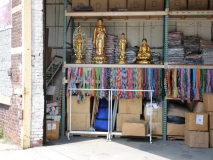
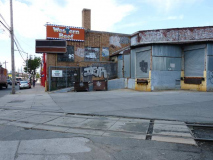







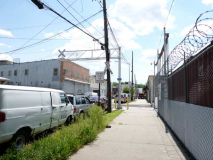







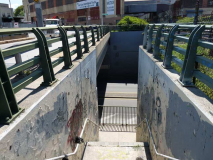
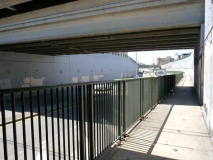



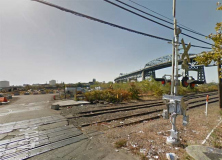





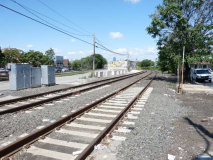

6 comments
Those are Buddhist statues.
Great stuff as usual-no matter how “Lego” they try to make NYC Kevin gets the real deal on film
According to the NTSB report, the runaway locomotive was not hauling freight cars, nor was it “accidentally uncoupled.” The train crew deliberately disconnected the locomotive and left it unattended. It rolled away due to the failure of safety devices in the air brake system, after the crew neglected to set the manual hand brake & wheel chocks as they were required to do.
http://www.ntsb.gov/doclib/reports/2005/RAB0501.pdf
Noted
What about the Cross Harbor Railroad in Sunset Park Brooklyn? The trains still run on 1st Ave and then cross 58th street to go into the Brooklyn Army Terminal. Also the MTA, I believe, still on occasion, have a train cross 3rd ave near Costco, at around 37th street.
The 50,000 watt WQEW 1560 directional transmission towers in Maspeth can be easily seen in one of the Flushing Avenue photos. They are no longer in use.